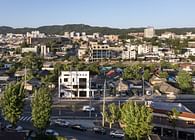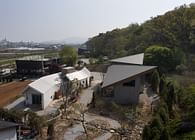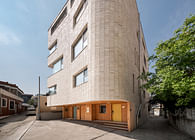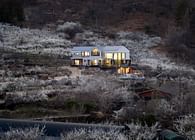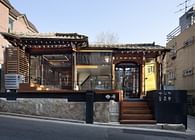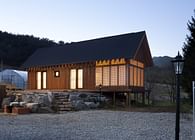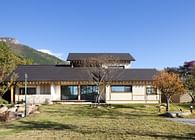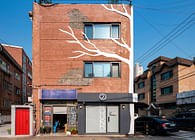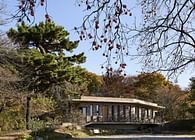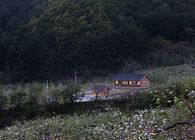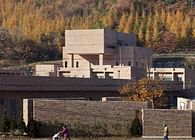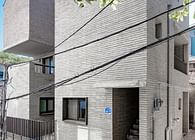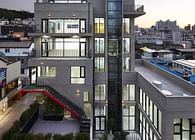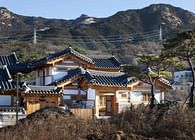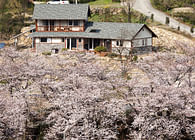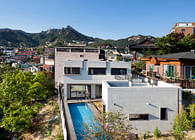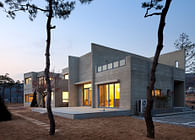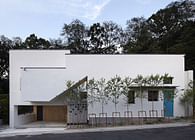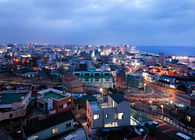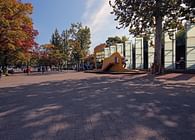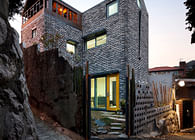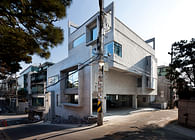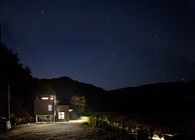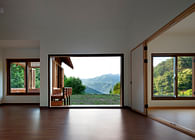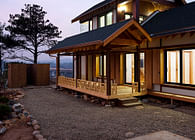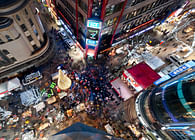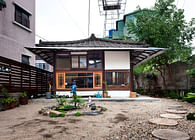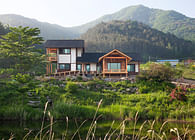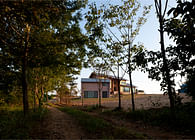
Seoul, KR
The Middle Way(Madhyamā-pratipad) is not the kind of enlightenment that comes at the end of suffering, but something that is ‘pleasant from the beginning, the middle and the end.’ Such is the core idea of Buddhism. The story was very fresh to me, having only very flat knowledge of the religion beforehand. The client, who told the tale, asked us to build a temple with the concept of Four Noble Truths (Saseongje) and Noble Eightfold Path (Paljeongdo). The temple is a house of the Buddha who has reached nirvana, and for the religious seeking to reach nirvana.
Two years ago, a monk with a slender body and an intelligent look, came to our office. With very concise and neat remarks, he told us that he was planning to build a Buddhist temple named 'Jetavana Seon (Zen) Center'. The design of temple for meditation and asceticism had already begun on the opposite mountain, and he was looking for an architect to design a facility called 'Kuti' (private accommodation meaning 'cabin') that will be separately built for believers to stay. One afternoon in May, the cool conversation, like a cool early autumn breeze, adding here and there a clumsy story about Buddhism that I knew a little bit, came to an end with his saying "So where do I sign to entrust the design?"
Strictly speaking, I am not a Buddhist. But I think that the basic spirit of all religions have something in common. I have a very ignorant and brave idea that the form of religion has changed only because of the historical situation and the various circumstances of the time when the religion was settled. In addition, since I am an architect, I am familiar with old houses including temples, high-class traditional Korean houses, and folk-houses. So I have to confess that I have a bit of old-fashioned view of architecture. I believe that building a temple was making a space that forms a process of going through the order, from Iljumun Gate (One Pillar Gate) and Cheonwang Gate (the temple gate dedicated to the Four Deva) to Bosaldan and Sinjungdan, and this is what I told monk on our first meeting, which formed the starting point for the work.
"Religion, although the goal maybe different, is the way to reach somewhere." And, to the extent of my knowledge, this is quite evident in the iconography of Buddhist Great Master Uisang <Beopseonge(法性偈)>. In fact, our religious architecture, especially Buddhist architecture, reveals an excellent interpretation of such a path and a marvellous sense of space. It tells a very wise solution, where it takes a few twists and turns, or swings around, rather than a straight line, and where topography and religious doctrine naturally melt in architecture.
The location to build the Seon (Zen) Center is in Chuncheon in terms of administrative district, but in fact it was a town called Gangchon, quite familar to me because I frequently visited there during college years or passed through with my friends on Gyeongchun railway Line. The site was a little narrow rice paddy facing an asphalt-paved road, a little narrower than two lanes but a little bit wider than one lane, passing through an idle village. Looking at the land, I planned the Kuti where the believers, who spend a few days to practice asceticism in the Seon (Zen) Room, will stay. Initially, I planned to make an overlapping square way, in which people would walk and meditate.
As the design continued, I heard interesting tales of Buddhist stories from the head monk of Seon Seon(Zen) Center. Among the guideline of the design that the monk suggested, the Four Noble Truths stands out, which deal with suffering, and the cause of suffering, and the way to remove them. This became the basic concept since this building is a space for asceticism in order to escape from suffering caused by obsession.
Another impressive story was the concept of 'Middle Way (Madhyamā-pratipad)', meaning "Pleasant from beginning to end". The concept was exciting. We live in strange obsession where living an idle, joyful life is considered like wasting time. In such an obsession, people are withering more and more. Wouldn’t it be so liberating if someone tells you “You can just have fun in life”!
That was the original teaching of Buddha, but over many years, many historical and local elements were added and the original spirit of Buddhism was severely damaged. The discussion sessions with the client was spent on listening to stories, not discussing the design.. In the course of a few months, major facilities such as Buddhist sanctuary and Seon (Zen) Room which were supposed to built on the opposite mountain, moved into the site we were designing. To that end, the adjoining land was added.
Jetavana is a Sanskrit, meaning "The Forest of Prince Zeta." It is called 'Jetavānā-nāthapiṇda dasyārāma' in Chinese characters and is abbreviated as Jetavana. Sudatta was busy looking for a land to build a temple for Buddha and eventually found the desired land. The land owner was Prince Zeta, and he said, "I will give you the land as much as you spread gold coins here," as an expression of his polite refusal to sell it. Sudatta then really began to lay gold coins on the land, and Prince Zeta was surprised and stopped him. Eventually Jetavana was built on this land, and it became the place that Sakyamuni stayed for the longest in his living years, naturally becoming a holy place.
In the course of design, I wanted to plan the temple for a modern lifestyle, embracing the old ways and Buddhist doctrines. Also, the head monk of Seon (Zen) Center was quite intent on returning to the original values of Buddhism. To restore the Buddhist basic spirit that Sakyamuni annotated and preached while sitting in Jetavana, this spirit was the biggest foundation for designing Jetavana Seon (Zen) Center.
In that sense, a brick, which symbolizes the remains of Jetavana, was an obvious choice. Unlike most traditional Korean temples, it was not built as a hanok, but we built the frames with a concrete structure and put bricks on them. But, considering the existing layout of traditional temple buildings, the path going inward through Iljumun Gate was designed to swerve three times, and by using the original elevation of the site topography, three stages were formed so that Jongmuso(temple office), Kuti, Yosache(temple house), and Buddhist sanctuary were placed according to the hierarchical order. It was a very old yet very innovative approach.
After a one-year design period, the construction begun. The space was completed with a total of 300,000 bricks used on building the frames, laying bricks outside, and spreading bricks on the floor. The construction also took a year. Throughout the year, I joyfully undertook the supervision, solving some difficult problems, polishing the land, building the house, and planting trees.
Thus, the space was completed, where the spirit of Middle Way “pleasant from beginning to end” pervades the house both indoors and out.
Status: Built
Location: 53, Witbagam-gil, Nam-myeon, Chuncheon-si, Gangwon-do, Republic of Korea
Firm Role: design, supervision
Additional Credits: Architect : Hyoungnam Lim, Eunjoo Roh in studio_GAON
Project Team : Sungpil Lee, Seongwon Son, ,joowon Moon, Laeyeon Kim, Minwoo Lee, Jaebeom Kim, Sora Yeom, Seunghwan Jung.
Photographs : Youngchae Park, Yongkwan Kim
Location : Bagam-ri, Nam-myeon, Chuncheon-si, Gangwon-do, Republic of Korea
Use : Religious facilities
Site Area : : 9,650㎡
Building Area : 1474.53㎡
Gross Floor Area : 1,718.46㎡
Building Scope : 7 Buildings, 2F
Height : 9.3m
Building-to-Land Ratio : 15.28%
Floor Area Ratio : 17.81%
Structure : Reinforced Concrete structure
Finish : Brick Classic
Supervision : Yoo deok
Design Period : 2016.11-2017.04
Construction Period : 2017.04-2018.05

